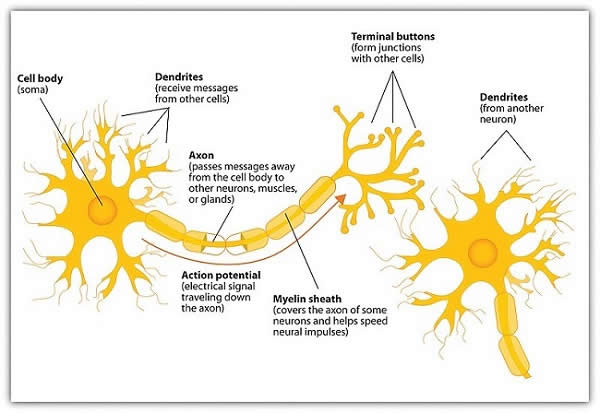Positive Health Online
Your Country

The Neuron Saga: Medicine's Fresh New Hope
by Rajgopal Nidamboor(more info)
listed in neurological and neurodegenerative, originally published in issue 285 - March 2023
Originally published in: thehimalayantimes.com
https://thehimalayantimes.com/opinion/the-neuron-saga-medicines-fresh-new-hope
You are what you are isn't as simple as it sounds.
This is because who we are is based not just on our identities, but also our dreams, hopes, intelligence, memories, the world around us, and neurobiology.
Diagram of Basic Neuron and Components
Credit: Wikipedia
https://en.wikipedia.org/wiki/File:Components_of_neuron.jpg
Neurobiology is the study of the nervous system and how the brain works, its anatomy, physiology, or functioning, with emphasis on how our cells generate and control behaviour.
It not only corresponds to the co-ordinated management of such cells as functional circuits, but also just as much with neurons as silicon chips in a computer. Neurons are nerve cells specialized to receive, disseminate, or transmit electrochemical impulses. There are billions of neurons – each as diverse in their structural features as the physiological function.
The human brain is loaded, especially during the initial stages of its development, with a glut of unstipulated connections between neurons. When our development and learning expand, the connections are 'clipped', leaving the stronger and more specific neurons. This fine-tuning bids fair to a definitive response – it refines a glut of inputs from our surroundings.
Research evidences that this 'modified' outcome acts as a 'go-between' for changes at the synapses. Synapses are like railway junctions – they are specialized neural intersections through which neurons communicate with each other.
Neurons are also endowed with specialized branched projections from the cell body. These are known as dendrites – they not only receive information, but also form synaptic contacts with other nerve cells and allow nerve impulses to be broadcast. This leads to patterns that optimize synaptic interactions. This holds the key in the progression of making proteins that are essential for long-term changes in synaptic connectivity.
New expanding research in neurobiology holds fresh hope to people suffering from emotional disorders, autism or other developmental illnesses. This is because it holds the prospect of early diagnosis. Research has identified the protein calcineurin (CaN) that controls synapse formation, action and function. CaN has been implicated in 'snappy' connections between cells. This has led to the development of a technique that specifically blocks the interaction between CaN and other cell factors at the nucleus. This, in effect, is also evidenced to analyse the effects of neuronal connections in the visual system. Research suggests that inhibiting such a CaN function results in more dendritic branches and synapses, too.
As new insights emerge with regard to how neurons control the growth of intricate branches of dendrites, scientists are confident that this could soon help them to better understand brain development. This would, in turn, enable them to also treat and restore neuronal connections lost due to brain injury, stroke and/or other neurodegenerative disorders.
New research suggests that structures called 'Golgi outposts' play a crucial role as distribution points for proteins, the building blocks of emergent dendrites.
The Golgi apparatus is a cellular depot, responsible for receiving, cataloguing and transporting the cargo of newly synthesised molecules needed for cell growth and function.
Golgi has a typecast composition, a loaded system housed near the cell nucleus. While neurons in our brain are vast, with a surface area about ten thousand times that of an average cell, it is, indeed, a big question as to where all the membrane components emerge from to 'spawn' the composite surface of growing dendrites.
Recent research has found a plausible answer – that such distant structures in dendrites, called the Golgi outposts, hold a decisive responsibility.
New studies have shown that the Golgi outposts are prone to materialize in longer dendrites, including Golgi, in the main cell body, which becomes acquainted with longer dendrites.
Studies suggest that growing dendrites are homogeneous in length; they also grow at a consistent rate.
However, when the Golgi traverses towards one dendrite, it grows animatedly to emerge as the longest dendrite, while establishing itself at 'preferred' dendritic branch points.
The outcome of such studies could offer significant evidence into the mechanism, regulation and control of neuronal growth. The upside of such research endeavours is imminent – it would not only establish, but also provide a clinical bearing on brain development disorders, which present, or manifest, with abnormal dendritic structures.
It is evidenced that most neurodegenerative diseases, including Parkinson's and Alzheimer's, are outcomes of flawed protein processing. The downside is we do not, as yet, irrefutably know as to how and where integral membrane proteins are synthesised and processed by neurons.
Once this happens, it would very well be the embodiment of reaching the next level – in terms of managing brain disorders with better, clinically safe and effective therapeutic outcomes.
It would be exciting, in the context, to note that researchers in Sweden had embarked on the first artificial nerve cell device which communicates with nerves and neurotransmitter chemicals, in their 'own language' – not electrical impulses.
Their device employs the same neurotransmitters that natural nerves use.
While the technology is still in its formative avatar, medical scientists are cocka-hoop with the electrifying potential it holds in bringing about a paradigm shift in brain-electronics interaction.
The next big, exhilarating leap is – as artificial nerve cell technology becomes smaller and affordable, 'synthetic' nerves could be used to create bionic brain prostheses for brain injury and stroke victims. This is not all. It could also be, with good effect, employed as a 'go-between' biological brains and electronic networks - a new renaissance for medicine.
Acknowledgement Citation
Originally published in: thehimalayantimes.com
A version of this article appears in the print on February 9, 2022 of The Himalayan Times.
https://thehimalayantimes.com/opinion/the-neuron-saga-medicines-fresh-new-hope
Comments:
-
No Article Comments available
